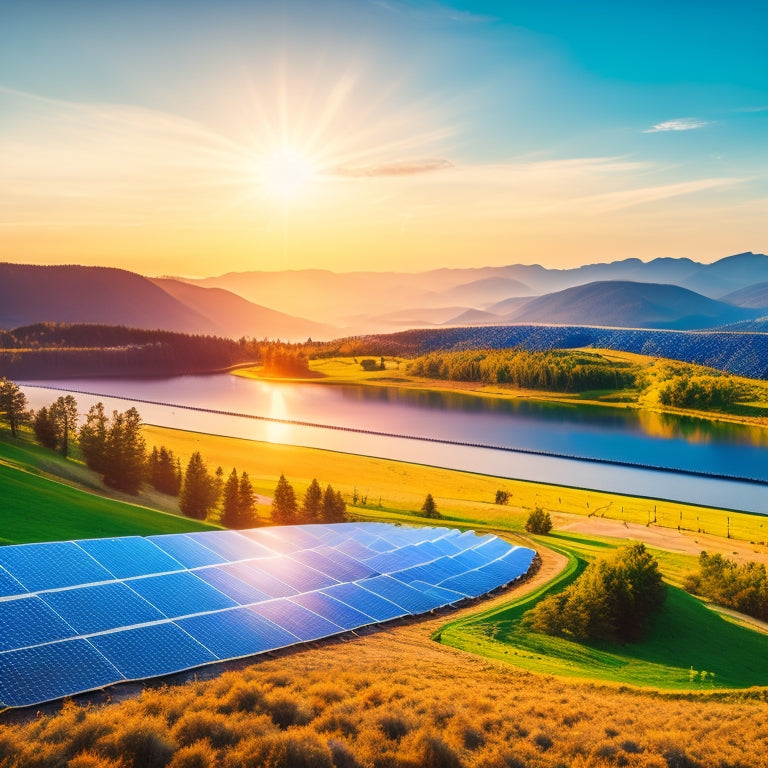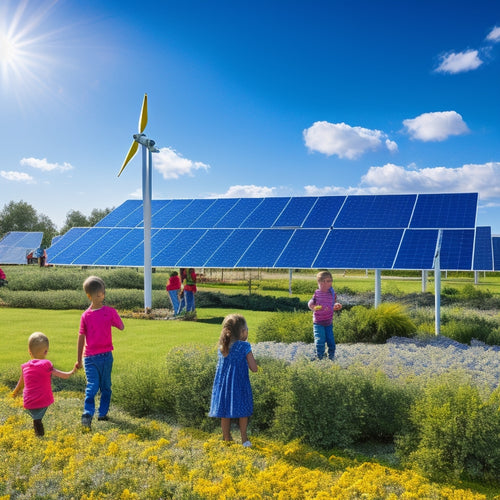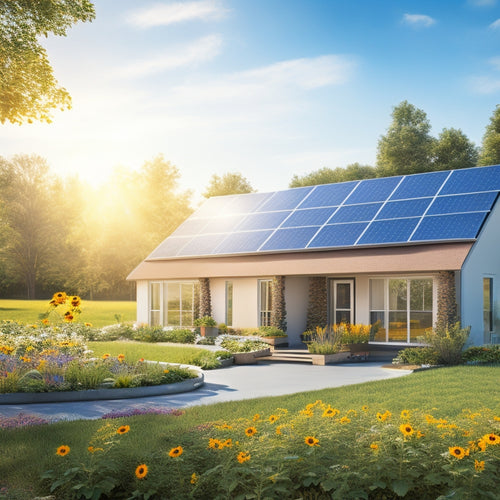
Benefits of Using Renewable Energy Sources
Share
Using renewable energy sources offers you significant cost savings, lower utility bills, and reduced reliance on fossil fuels. By switching, you can save an average of $1,500 annually with solar panels alone. It's not just about savings; renewables also drastically reduce greenhouse gas emissions by up to 80%, enhancing air quality and promoting a healthier planet. Additionally, they spur job creation and strengthen local economies, all while supporting habitat preservation. This shift contributes to a sustainable future. There's much more to investigate about how this choice shapes both your finances and the environment.
What You Need to Know
- Switching to renewable energy sources leads to significant long-term savings on utility bills and reduces overall energy costs.
- Federal tax credits and state rebates lower initial investments in renewable technologies, making them more financially attractive.
- Renewable energy significantly reduces greenhouse gas emissions, contributing to climate change mitigation and improved air quality.
- The transition to renewables fosters economic growth by creating jobs in sustainable industries and boosting local economies.
- Renewable projects promote habitat preservation and biodiversity, ensuring healthier ecosystems for future generations.
Cost-Effective Long-Term Savings
When you switch to renewable energy sources, you're likely to see lower utility bills over time, as these systems often reduce your energy costs considerably.
Moreover, many homeowners are exploring ways to maximize their space and efficiency, similar to how efficient use of corner space can improve overall bathroom functionality.
In addition, tax incentives are available, providing you with immediate savings that can offset installation expenses.
Together, these factors make renewable energy not just an environmentally friendly choice, but also a financially savvy one.
Lower Utility Bills
Lower utility bills represent one of the most convincing advantages of adopting renewable energy sources. By utilizing solar, wind, or hydro energy, you can greatly reduce your monthly expenses. Studies show that homeowners who install solar panels can save an average of $1,500 annually on their energy bills. This isn't just a temporary relief; it's a long-term strategy that improves your financial freedom.
Additionally, many commercial photovoltaic systems offer considerable long-term savings through reduced electricity bills and various financing options that can lower upfront costs, making them an attractive choice for businesses looking to invest in cost-effective solar solutions.
Moreover, renewable energy sources often lead to increased energy efficiency. When you invest in these technologies, you're not just cutting costs; you're also minimizing waste. Energy-efficient appliances and smart grid technology further improve your savings by optimizing how you consume power.
As you investigate utility alternatives, you'll find that renewable energy can insulate you from rising utility rates. Traditional energy sources are subject to market fluctuations, but the sun and wind are free. By embracing these options, you can reclaim control over your energy consumption and expenses.
Shifting to renewable energy not only means lower bills but also aligns with a sustainable lifestyle that encourages independence. In a world where freedom is paramount, reducing your reliance on conventional utilities is a powerful step toward financial and personal liberation.
Tax Incentives Available
Tax incentives available for renewable energy investments can greatly enhance your financial savings over time. By leveraging federal credits and state rebates, you can considerably reduce upfront costs associated with adopting renewable technologies.
For instance, the federal solar tax credit allows you to deduct a substantial percentage of your solar installation costs from your federal taxes, providing immediate financial benefits. Additionally, various state and local incentives can further lower your expenses, making the shift to renewable energy even more attractive.
In addition to tax deductions, various investment incentives and renewable grants are designed to encourage the move to clean energy. These programs often include adoption subsidies that support both residential and commercial projects, making renewable energy even more accessible.
Policy support at both federal and state levels further enhances the attractiveness of these investments. By taking advantage of these incentives, you not only save money but also contribute to a more sustainable future.
Ultimately, the combination of tax incentives and financial benefits not only enables you to invest in renewable energy but also aligns with your desire for independence from fluctuating energy prices.
Embracing these opportunities can lead to cost-effective, long-term savings, enhancing your financial freedom while promoting environmental stewardship.
Environmental Impact Reduction
When you consider renewable energy sources, you'll notice a significant reduction in greenhouse gas emissions compared to fossil fuels.
By utilizing eco-friendly materials in the production of renewable energy systems, you not only lower carbon footprints but also contribute to habitat preservation efforts.
This dual benefit highlights the importance of renewable energy in promoting a healthier environment.
Decreased Greenhouse Gas Emissions
The change to renewable energy sources greatly reduces greenhouse gas emissions, an essential factor in combating climate change. By utilizing solar, wind, and hydro power, you're not only lessening your carbon footprint but also contributing to a more sustainable future. Data shows that shifting to these energy sources can cut emissions by up to 80% compared to fossil fuels. This alteration is crucial for enhancing climate resilience, as it helps communities adapt to the impacts of climate change.
Additionally, installing solar panels can greatly reduce reliance on finite fossil fuels, providing a clean and renewable energy source that minimizes emissions and supports eco-friendly practices renewable energy benefits.
Moreover, renewable energy sources often incorporate innovative technologies like carbon capture, which further mitigates emissions. These technologies capture CO2 from the atmosphere, allowing you to actively participate in reducing greenhouse gases.
As you support and adopt renewable energy, you're enabling yourself and your community, nurturing a sense of freedom from the constraints of traditional energy systems that contribute to environmental degradation.
In the face of increasing climate challenges, embracing renewable energy not only aligns with personal values of freedom and responsibility but also guarantees a healthier planet for future generations. By reducing greenhouse gas emissions, you're playing a crucial role in the global effort to combat climate change and protect the environment.
Habitat Preservation Efforts
Many people may not realize that renewable energy sources play a significant role in habitat preservation efforts, contributing to environmental impact reduction. By shifting to solar, wind, and hydroelectric power, you're actively reducing the need for fossil fuels, which can disrupt ecosystems and habitats. This change is critical for biodiversity conservation, as many species are threatened by habitat loss due to traditional energy practices.
Data indicates that renewable energy projects often include habitat restoration initiatives. For instance, solar farms can be designed to incorporate native vegetation, promoting local flora and fauna. This not only enhances biodiversity but also provides a healthier ecosystem that can better withstand climate fluctuations.
Moreover, wind energy installations are increasingly being placed in areas that minimize their impact on wildlife, demonstrating a commitment to preserving habitats while utilizing energy.
Ultimately, your choice to support renewable energy contributes to a larger movement towards sustainable environmental practices. By prioritizing these sources, you're not just securing energy freedom for yourself but also championing the restoration and preservation of essential habitats for future generations.
Key Advantages of Renewables
When considering renewable energy sources, you'll find significant advantages that extend beyond just reducing environmental impact.
By utilizing clean energy, you're not only contributing to a healthier planet but also releasing economic growth opportunities through job creation and innovation.
This dual benefit positions renewables as an essential component in shaping a sustainable future.
Environmental Impact Reduction
Altering to renewable energy sources considerably reduces environmental impacts compared to fossil fuels. By embracing sustainable practices, you contribute to ecosystem balance and enhance climate resilience. Renewable technology, such as solar and wind, emits little to no greenhouse gases, leading to improved air quality and reduced carbon footprints.
Here's a comparison of the environmental impacts of renewable vs. fossil fuels:
| Energy Source | Greenhouse Gas Emissions |
|---|---|
| Fossil Fuels | High |
| Renewable Energy | Low |
| Adapting | Minimal |
Energy diversification is essential for effective resource management and energy independence. By utilizing renewables, you're not just reducing emissions; you're also promoting ecological restoration and nurturing a healthier planet. This alteration encourages communities to invest in local resources, further enhancing their autonomy and resilience against climate change.
In essence, embracing renewable energy isn't just a personal choice; it's a collective movement towards a sustainable future. With every step you take, you're not only liberating yourself from fossil fuel dependence but also creating the path for a cleaner, greener world for generations to come.
Economic Growth Opportunities
As communities adopt renewable energy sources, they release significant economic growth opportunities that extend beyond mere environmental benefits. Shifting to renewables encourages job creation, particularly in sustainable industries such as solar and wind energy. According to the International Renewable Energy Agency, renewable sectors employed over 11 million people globally in 2018, and this figure continues to grow.
Energy independence is another key advantage. By utilizing local resources, communities can reduce reliance on imported fuels, keeping money circulating within the local economy. This leads to increased local investments and infrastructure development, which are essential for long-term economic stability.
Technological innovation thrives in renewable energy sectors, driving advancements that further enhance efficiency and reduce costs. Engaging the community in these projects not only elevates local economies but also promotes a sense of ownership and responsibility towards sustainability.
Moreover, integrating renewable energy sources enhances future resilience against climate change and economic fluctuations. As you support these initiatives, you're not just contributing to a greener planet; you're also creating the foundation for strong economic growth and a thriving local community.
Embracing renewables is a pathway to freedom—both economically and environmentally.
Assessing Energy Source Compatibility
When evaluating energy source compatibility, you need to contemplate the unique characteristics of each renewable option and how they align with your current systems.
For instance, solar and wind energy have distinct generation patterns, which can affect their integration into existing grids.
Understanding these factors is essential to optimizing energy efficiency and ensuring a seamless shift to renewables.
Energy Source Characteristics
Understanding the characteristics of various energy sources is essential for appraising their compatibility with existing infrastructures and energy needs. You need to take into account factors such as energy source diversity and technological advancements to determine which sources align best with your objectives.
Here's a simple breakdown of key energy sources:
| Energy Source | Availability | Environmental Impact |
|---|---|---|
| Solar | High | Low |
| Wind | Moderate | Low |
| Biomass | Variable | Moderate |
By evaluating these characteristics, you can identify energy sources that not only meet your demand but also promote a sustainable future. Solar energy, widely available and low-impact, exemplifies how renewable sources can fulfill energy needs without compromising the environment. Wind energy offers a more moderate availability but similarly boasts a minimal environmental footprint. Meanwhile, biomass presents variable availability and a moderate impact, highlighting the importance of innovation in utilizing this resource effectively.
Ultimately, understanding these energy source characteristics enables you to make informed decisions, ensuring that your energy strategy aligns with both current capabilities and future aspirations.
Integration With Existing Systems
Integrating renewable energy sources with existing systems is essential for maximizing efficiency and minimizing disruptions. To achieve this, you need to focus on system adaptation and grid compatibility. By evaluating the existing infrastructure, you can identify necessary upgrades that allow for smoother technology integration.
For instance, incorporating smart systems enables real-time energy management, which is critical for optimizing performance.
Hybrid solutions can play a significant role in this integration process. By combining traditional energy sources with renewables, you can guarantee a stable power supply while benefiting from the environmental advantages of clean energy. This approach also mitigates risks associated with fluctuating renewable energy outputs, enhancing overall reliability.
Moreover, investing in infrastructure upgrades is key to supporting renewable energy integration. These upgrades make sure that your energy systems can handle increased loads and variations in energy supply.
Ultimately, a well-planned integration strategy leads to better performance optimization, revealing the full potential of renewable sources. Embracing these strategies not only enables you to utilize the freedom that renewable energy offers but also positions you as a leader in the shift to a sustainable future.
Lower Carbon Footprint Overall
When you switch to renewable energy sources, you greatly reduce greenhouse gas emissions.
Data shows that renewables can cut emissions by up to 70% compared to fossil fuels, directly impacting climate change mitigation.
Reduced Greenhouse Gas Emissions
The shift to renewable energy sources plays an essential role in decreasing greenhouse gas emissions and lowering your carbon footprint. As you change from fossil fuels to wind, solar, or hydroelectric energy, you're actively contributing to a significant reduction in carbon dioxide and methane emissions, which are principal culprits in climate change.
For instance, a study from the International Renewable Energy Agency (IRENA) suggests that doubling the use of renewables could avoid over 70 gigatons of CO2 emissions annually by 2050—an outstanding step towards achieving carbon neutrality goals.
Moreover, utilizing renewable energy aligns with sustainable development principles, ensuring that current energy demands don't compromise future generations' needs. By embracing this change, you're not only reducing harmful emissions but also encouraging energy independence and security.
The advantages extend beyond environmental impacts; they also stimulate economic growth and job creation in the renewable sector.
Ultimately, by choosing renewable energy, you're taking a powerful stand for a cleaner planet, enhancing your freedom from the volatility of fossil fuel markets, and supporting a healthier, sustainable future for all.
Frequently Asked Questions
How Do Renewable Energy Sources Affect Job Creation?
Renewable energy sources drive job growth by creating green jobs and enhancing economic impact. You'll find increased employment opportunities through workforce training and energy innovation, nurturing sustainable careers that benefit communities and promote a thriving, independent future.
What Are the Challenges of Transitioning to Renewable Energy?
Shifting to renewable energy presents challenges like grid integration and energy storage. You'll face obstacles in technology innovation, public awareness, infrastructure investment, resource availability, and financial incentives, all while considering the environmental impact of these changes.
How Reliable Are Renewable Energy Sources During Extreme Weather?
During extreme weather, 70% of energy storage systems enhance grid resilience. By leveraging technology advancements and system adaptability, you can improve emergency preparedness against shifting weather patterns, ensuring reliable energy access when it's most needed.
Can Renewable Energy Power Large-Scale Industries Effectively?
You'll find renewable technologies can effectively power large-scale industries by providing consistent industrial energy. Data shows that advancements in energy storage and grid integration enhance reliability, enabling industries to thrive while embracing sustainable practices.
What Role Do Government Policies Play in Renewable Energy Adoption?
Government policies shape renewable energy adoption considerably. Incentives impact investment decisions, while regulatory structures create a stable environment. By understanding these elements, you can steer through opportunities for sustainable growth, maximizing freedom in energy choices.
Explore More
Incorporating renewable energy sources isn't just a trend; it's a smart investment for your future. While some may argue that initial costs can be high, consider the long-term savings and environmental benefits that far outweigh these concerns. By reducing reliance on fossil fuels, you're not just cutting costs—you're contributing to a healthier planet and a more sustainable economy. Embracing renewables means you're taking a proactive step toward a cleaner, more resilient energy future for everyone.
Related Posts
-

Solar Power for Community Energy Independence
Solar power is essential for your community's energy independence, offering both environmental and economic benefits....
-

Home Solar Systems for Environmental Impact
Home solar systems markedly reduce your carbon footprint by utilizing renewable energy. By adopting solar energy, you...
-

High-Performance Energy-Efficient HVAC Systems
High-performance energy-efficient HVAC systems are essential for reducing energy consumption while improving indoor c...


